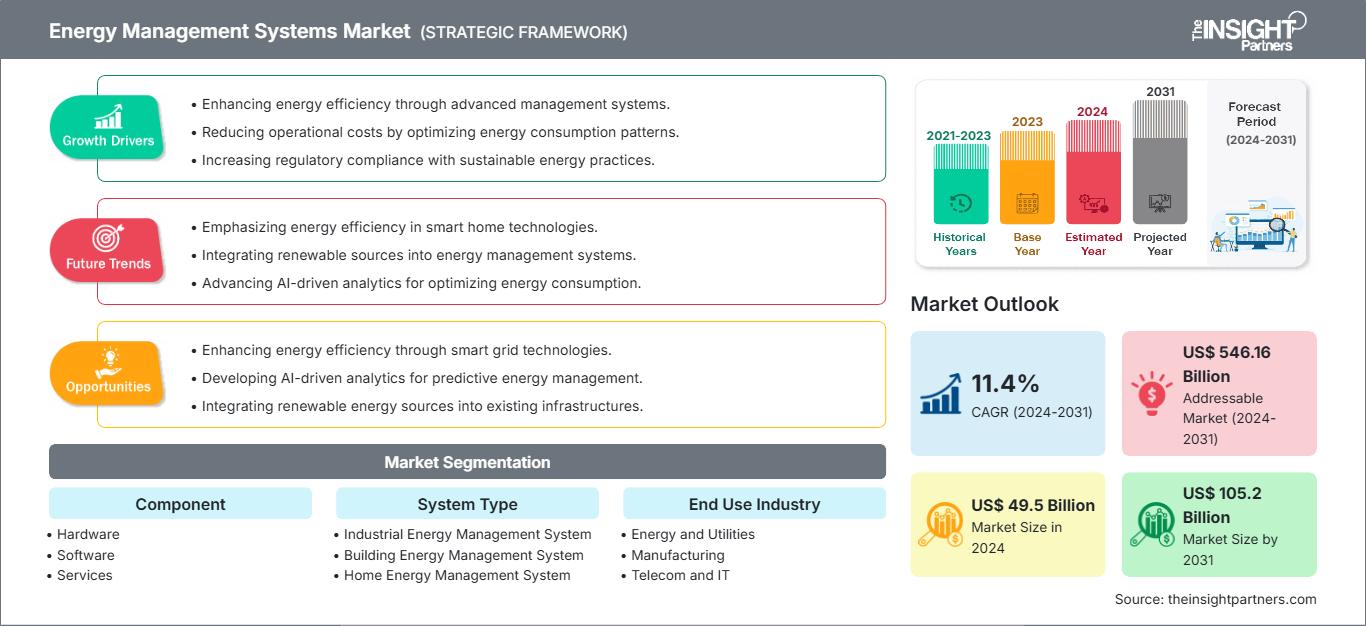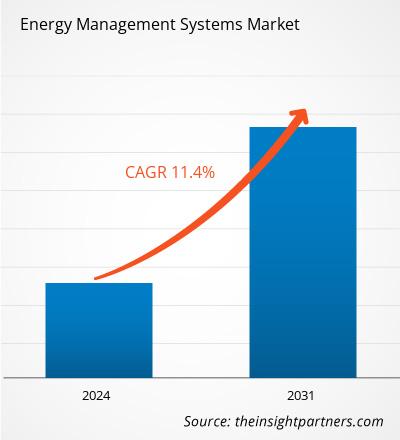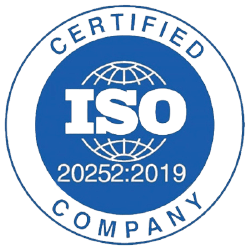エネルギー管理システム市場規模は、2024年の495億米ドルから2031年には1052億米ドルに達すると予想されています。市場は2024年から2031年の間に11.4%のCAGRを記録すると予測されています。エネルギー管理システムの技術開発の成長は、今後数年間で市場に新しいトレンドをもたらすことが予想されます。
エネルギー管理システム市場分析
エネルギー管理システムは、製造、自動車、通信およびIT、住宅および商業、エネルギーおよび公益事業など、さまざまな業界でますます導入されています。スマートエネルギー管理システム(SEMS)は、モノのインターネット(IoT)接続を活用して、建物やオフィスビルのエネルギー消費を追跡、測定、制御、最適化する技術の1つであり、さまざまな業界でのエネルギー消費の効率的な管理に役立ちます。政府および民間企業による省エネ、持続可能性目標、および業界プレーヤーやその他の住宅および商業施設の炭素排出削減に向けたインセンティブに向けた取り組みの増加により、エネルギー管理システムはますます重要になっています。世界中の商業顧客からの需要の増加は、EMS市場で事業を展開する企業に対し、製品開発、合併、提携、コラボレーションなどの主要な戦略的開発の採用を促すことが期待されています。たとえば、2024年5月には、シーメンススマートインフラストラクチャとエンポリアが「Inhab Energy Monitor」という家庭用エネルギー監視ソリューションを発表しました。この新しいエネルギー監視ソリューションは、電力使用量を継続的に監視することで、家庭内のエネルギー消費を削減します。2024年4月には、Powerley(家庭用エネルギー管理会社)がPowerlay Liveを発売し、公益事業者が家庭レベルで仮想発電所を確立するのを支援し、顧客が機器の使用状況を監視し、正確な負荷予測と制御を行えるようにしました。
エネルギー管理システム市場の概要
エネルギー管理システムは、施設、組織、または複数の場所におけるエネルギー消費を監視、制御、最適化するための総合的なソリューションです。このシステムは、ハードウェア、ソフトウェア、分析ツールを統合し、エネルギー消費パターンに関するリアルタイムの洞察を提供し、改善の機会を特定し、エネルギー効率と持続可能性を向上させる戦略を実行します。エネルギー管理システムのコア機能には、データ取得、監視、自動化と制御、デマンドレスポンスと負荷管理、エネルギー消費分析とレポート、分散エネルギーリソースの統合などがあります。世界中のエネルギー管理システムの主なエンドユーザーには、製造業、住宅および商業ビル、エネルギーおよび公共事業、データセンター、小売店、ホテル、工業施設(製造業以外)などがあります。
センサーと測定デバイスは、あらゆるエネルギー管理システムのコアコンポーネントです。これらのツールは、現場、建物、部屋、施設での正確なエネルギー消費データを提供し、詳細な分析を行って非効率性を特定し、改善すべき領域を特定できるようにします。高度なセンサーは、温度、湿度、デバイスのパフォーマンスなどの変数を測定し、エネルギー消費の全体像を提供します。最先端のEMSプラットフォームは、人工知能(AI)と機械学習アルゴリズムを使用して、エネルギーニーズを予測し、傾向を特定し、非効率性を浮き彫りにします。これらの技術はエネルギー消費パターンを予測し、よりスマートな意思決定を可能にします。
エネルギー管理システム市場の成長を牽引する主な要因としては、成長著しいデータセンター業界におけるエネルギー有効活用に向けた政府の取り組み、エネルギー効率向上のためのシステム導入の増加、そして再生可能エネルギー産業の成長などが挙げられます。しかしながら、エネルギー管理システムプロジェクトの実行における障壁が市場の成長を阻害すると予想されます。エネルギー管理システムの技術開発は、予測期間中に市場で事業を展開する企業にビジネスチャンスを生み出すと予測されています。さらに、家庭用エネルギー管理システムへの需要増加は、2024年から2031年にかけての市場の成長軌道に影響を与えると予想されます。
要件に合わせてレポートをカスタマイズ
レポートの一部、国レベルの分析、Excelデータパックなどを含め、スタートアップ&大学向けに特別オファーや割引もご利用いただけます(無償)
エネルギー管理システム市場: 戦略的洞察

- このレポートの主要な市場動向を入手してください。この無料サンプルには、市場動向から見積もりや予測に至るまでのデータ分析が含まれます。
レポートの一部、国レベルの分析、Excelデータパックなどを含め、スタートアップ&大学向けに特別オファーや割引もご利用いただけます(無償)
エネルギー管理システム市場: 戦略的洞察

- このレポートの主要な市場動向を入手してください。この無料サンプルには、市場動向から見積もりや予測に至るまでのデータ分析が含まれます。
エネルギー管理システム市場の推進要因と機会
家庭用エネルギー管理システム導入の増加傾向
家庭用エネルギー管理システムは、特定の目標を達成するために、家の中のエネルギーフローを監視および最適化します。住宅部門におけるエネルギー消費に対する野心的な規制が、HEMSの推進力となっています。たとえば、建物のエネルギー性能指令などの太陽光発電屋根に関するEU基準は、2023年5月初旬に導入され、2026年から2030年の間にEUで150~200GWの追加の屋上太陽光発電が設置されると予想されています。これは、5600万人の住民に電力を供給するのに十分な容量です。これは、今後数年間で屋上PVの潜在能力が徐々に活用されることを意味します。
成長する再生可能エネルギー産業
化石燃料を使用した発電は、気候変動につながる温室効果ガス(GHG)排出の主な原因です。そのため、世界中の多くの政府が二酸化炭素排出量の削減とクリーンエネルギーへの移行に注力しており、グリーンエネルギー生産への投資を促進しています。クリーンエネルギーとグリーンエネルギーの利用への注目の高まり、気候変動への懸念の高まり、再生可能エネルギーの利用を促進するための政府の取り組みの増加により、太陽光と風力エネルギーの利用が増加しています。国際エネルギー機関(IEA)によると、世界の再生可能電力発電量は、今世紀末までに17,000テラワット時(TWh)を超え、2023年より約90%増加すると予測されています。これは、2030年の中国と米国の合計電力需要を満たすと予想されています。今後5年間で、いくつかの再生可能エネルギーのマイルストーンが達成されると予想されています。2025年には、再生可能エネルギーによる発電量が石炭火力発電を上回ると予想されています。2026年には、風力と太陽光発電が原子力発電を上回ると予想されています。そして、2029年には、太陽光発電による発電量が水力発電を上回り、世界最大の再生可能エネルギー源になると予想されており、同様に風力発電も2030年までに水力発電を上回ると予想されています。
エネルギー管理システム市場レポートのセグメンテーション分析
エネルギー管理システム市場分析の導出に貢献した主要なセグメントは、コンポーネント、システムタイプ、および最終用途産業です。
- コンポーネントの面では、市場はハードウェア、ソフトウェア、およびサービスに分類されます。2024年には、ハードウェアセグメントが市場を支配しました。
- システムタイプに基づいて、市場は産業用エネルギー管理システム、ビルエネルギー管理システム、および家庭用エネルギー管理システムに分かれています。2024年には、産業用エネルギー管理システムセグメントが市場を支配しました。
- 最終用途産業に基づいて、市場はエネルギーおよび公益事業、製造、通信およびIT、住宅および商業、その他に分かれています。 2024年には製造業が市場を支配しました。
エネルギー管理システムの地域別市場シェア分析
エネルギー管理システム市場は、北米、ヨーロッパ、アジア太平洋(APAC)、中東およびアフリカ(MEA)、南米および中米の5つの主要地域に分割されています。2024年には北米が市場を支配し、ヨーロッパとアジア太平洋がそれに続きました。
ヨーロッパには、自動化、ロボット工学、産業用IoT(Internet of Things)、インダストリー4.0などの最先端技術を使用する確立された製造業があります。ヨーロッパでは、技術の進歩により、エネルギー管理システムの競争の激しい市場が生まれています。ヨーロッパは世界で最も重要な自動車メーカーの1つです。フォルクスワーゲンAG、ステランティスNV、メルセデス・ベンツグループAG、バイエリッシェ・モトーレンヴェルケAG、ルノーSAなど、世界をリードする自動車メーカーの存在が、業界の成長を牽引しています。これらのメーカーは、円滑な運営のために電気やエネルギーを必要とするため、エネルギー管理システムの導入が進んでいます。ドイツはヨーロッパ最大の経済大国であり、自動車、航空、エレクトロニクス、化学、食品加工など、いくつかの主要な産業分野が集まっています。欧州自動車工業会(ACEA)によると、ドイツの新車登録台数は、2022年の265万台から2023年には約284万台に達し、約7%の増加となっています。ドイツはヨーロッパ最大の自動車ハブであり、2023年の乗用車生産台数の25%以上、新車登録台数の約20%を占めています。ドイツは2023年にヨーロッパ最大の乗用車生産国となり、同国の製造工場では年間約17%の増加で約310万台の生産が記録されました。このデータは、ドイツには自動車製造のための確立されたエコシステムがあり、製造または加工作業における電力需要を促進し、その結果としてエネルギー管理システムの採用が促進されていることを示しています。
エネルギー管理システム市場レポートの範囲
エネルギー管理システム市場のニュースと最近の開発
エネルギー管理システム市場は、重要な企業の出版物、協会データ、データベースを含む一次および二次調査後の定性的および定量的データを収集することによって評価されます。エネルギー管理システム市場における重要な開発のいくつかを以下に示します。
- エネルギー管理と次世代オートメーションのデジタルトランスフォーメーションのリーダーであるシュナイダーエレクトリックは、ノイダ国際空港と戦略的パートナーシップを結び、建物およびエネルギー管理ソリューションを導入しました。このコラボレーションを通じて、シュナイダーエレクトリックは、空港の運用効率と持続可能性を高めることを目的として、電気SCADAと高度配電管理システムで構成された完全な建物管理ソリューションを展開します。 (出典: シュナイダーエレクトリック、プレスリリース、2024 年 10 月)
- ABB は、複数の産業資産とプロセスの協調制御を提供し、エネルギー効率の向上、排出量の削減、脱炭素化をサポートする、主力のデジタルエネルギー管理および最適化システムの最新バージョンである ABB Ability OPTIMAX® 6.4 をリリースしました。 (出典:ABB、プレスリリース、2024年6月)
エネルギー管理システム市場レポートの対象範囲と成果物
「エネルギー管理システム市場規模と予測(2021~2031年)」は、以下の分野を網羅した市場の詳細な分析を提供します。
- 調査対象となるすべての主要市場セグメントにおける、世界、地域、国レベルでのエネルギー管理システム市場規模と予測
- エネルギー管理システム市場の動向、推進要因、制約要因、主要な機会などの市場動向
- 詳細なPEST分析とSWOT分析
- 主要な市場動向、世界および地域の枠組み、主要プレーヤー、規制、および最近の市場動向を網羅したエネルギー管理システム市場分析
- 市場集中、ヒートマップ分析、主要プレーヤー、およびエネルギー管理システム市場の最近の動向を網羅した業界展望と競争分析
- 詳細な企業プロファイル
エネルギー管理システム市場の地域別分析
The Insight Partnersのアナリストは、予測期間を通じてエネルギー管理システム市場に影響を与える地域的な動向と要因を詳細に解説しています。このセクションでは、北米、ヨーロッパ、アジア太平洋、中東・アフリカ、中南米におけるエネルギー管理システム市場のセグメントと地域についても解説しています。
エネルギー管理システム市場レポートの範囲
| レポート属性 | 詳細 |
|---|---|
| の市場規模 2024 | US$ 49.5 Billion |
| 市場規模別 2031 | US$ 105.2 Billion |
| 世界的なCAGR (2024 - 2031) | 11.4% |
| 過去データ | 2021-2023 |
| 予測期間 | 2024-2031 |
| 対象セグメント |
By コンポーネント
|
| 対象地域と国 | 北米
|
| 市場リーダーと主要企業の概要 |
|
エネルギー管理システム市場のプレーヤー密度:ビジネスダイナミクスへの影響を理解する
エネルギー管理システム市場は、消費者の嗜好の変化、技術の進歩、製品メリットへの認知度の高まりといった要因によるエンドユーザーの需要増加に牽引され、急速に成長しています。需要の増加に伴い、企業は製品ラインナップの拡充、消費者ニーズへの対応のためのイノベーション、そして新たなトレンドの活用を進めており、これが市場の成長をさらに加速させています。

- 入手 エネルギー管理システム市場 主要プレーヤーの概要
- 過去2年間の分析、基準年、CAGRによる予測(7年間)
- PEST分析とSWOT分析
- 市場規模価値/数量 - 世界、地域、国
- 業界と競争環境
- Excel データセット
最新レポート
関連レポート
お客様の声
購入理由
- 情報に基づいた意思決定
- 市場動向の理解
- 競合分析
- 顧客インサイト
- 市場予測
- リスク軽減
- 戦略計画
- 投資の正当性
- 新興市場の特定
- マーケティング戦略の強化
- 業務効率の向上
- 規制動向への対応




















 無料サンプルを入手 - エネルギー管理システム市場
無料サンプルを入手 - エネルギー管理システム市場